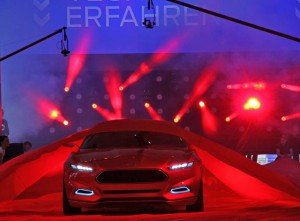
The Ford Evos was one of an estimated 100 new cars, crossovers and concepts to make a debut at this year's Frankfurt Motor Show.
With one of the biggest displays of new cars, crossovers and concept vehicles ever, the biennial Frankfurt Motor Show saw public attendance surge by 10%, according to the show’s organizers, suggesting the auto industry’s future is brighter than the turmoil in the financial markets might suggest.
The Frankfurt show, which describes itself as the world’s “most important mobility trade fair” opened on September 15 and closed its gates 10 days later, with a preliminary count of 928,000 paying visitors, organizers reported.
“This stream of visitors demonstrates that for many people the fascination exerted by cars continues unabated” proclaimed Matthias Wissmann, President of the German Association of the Automotive Industry, in a statement summing up the show.
“In these times of turbulence on the finance markets, the IAA has sent out strong signals of stability in manufacturing and of automotive growth. For the politicians, here it has become visible and comprehensible, just how strong the manufacturing sector is, and the innovative drive for the future that characterizes this industry,” Wissman added.
Also known as the IAA, the 64th Frankfurt Motor Show drew more exhibitors than ever before, as well, a total of 1,012 gobbling up nearly 2.5 million square feet of exhibition space in a dozen buildings that sprawled over a conference center that runs nearly a full kilometer from one end to the other.
But what drew in the crowds were the new products and concepts. As in past years, the focus at Frankfurt was on green, high-mileage technology, with the new Volkswagen Up! getting its official launch during the 2-day media preview. (Click Here for more on the VW microcar.) Even luxury makers put a premium on small, high-mileage products, such as the new Mercedes-Benz B-Class. (Click Here for more.)
German makers have traditionally dominated their home market show – and did so again this year. But they also had to concede time and space to some aggressive rivals, notably including Japanese makers like Toyota, which unveiled an assortment of new models including the compact Avensis, the Prius+ hybrid and the all-new Prius Plug-in. (Click Herefor more on that offering.)
High-tech was a watchword of the show – in the passenger compartment, as well as under the hood, with most makers this year offering up new telematics technologies that can deliver real-time traffic, Internet-based radio services and even the ability to check in with Facebook.
“(Motorists) want the Internet and individual mobility,” Wissmann said. They want efficient vehicles that at the same time meet their demands for high levels of safety, comfort, quality and design – and all of that at affordable prices,” he said.
The international nature of this IAA was reflected in the fact that one in five visitors came from abroad. And one in five of those foreign guests came from Asia – whereas two years ago the figure was only one in eight. The show also attracted more than 12,000 journalists came from 98 countries.
The significance of the IAA as a platform for dialog between politics and business was “greater and more important than ever before,” Wissmann added, noting German Chancellor Angela Merkel, several members of the German Government and numerous state premiers and other state-level politicians to the IAA, all visited the show.
